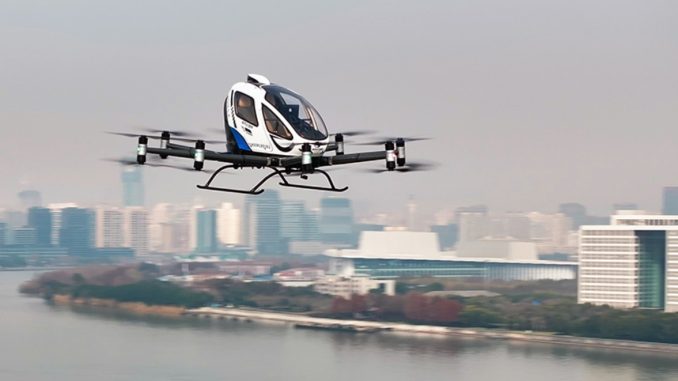
Multiple media reports say EHang has received acceptance of its Air Operator Certificate (AOC) application from the Civil Aviation Administration of China (CAAC) for its EH216-S, paving the way for commercial operations.
According to China’s Global Times, quoting a report by the China Central Television (CCTV) on Sunday. “The OC, issued by CAAC, used to confirm that the autonomous passenger drone meets the country’s safety operation standards. The companies with the operation certificates can carry out commercial operations in approved air space, provide paid passenger services, the CCTV report said….The two OC certificates were granted to Chinese drone makers EHang Holdings Limited in South China’s Guangdong Province, and Hefei Hey Airlines Co in East China’s Anhui Province.”
“EHang Holdings’ EH216-S, operated by the two companies, is the world’s first and China’s only passenger-carrying unmanned electric vertical take-off and landing (eVTOL) aircraft that to have obtained all three certificates, the Global Times learned from EHang. Having successfully completed over 60,000 safe flights, the eVTOL is set to facilitate urban air mobility, logistics, and sightseeing tourism, and the issuance of the OC certificate marks the beginning of the commercialization of urban air mobility to the general public, Ehang said in a statement sent to the Global Times.”
According to a Linkedin post from Rakesh Kumar Yadav, Senior Fellow at Centre for Air Power Studies, in Delhi, India: “”The certificate limits Hefei Heyi Aviation to low-altitude sightseeing tourism in Hefei Luogang Park. The AOC does not authorize urban air mobility services.
“Restrictions include:
(i) Flights must be conducted during daytime hours and in normal weather conditions.
(ii) Operations are restricted to sparsely populated areas, on pre-approved routes in non-controlled airspace.
(iii) The aircraft must remain within the visual line of sight of the remote pilot.
(iv) Flight altitude must not exceed 120 meters (~394 feet), and the overall operational altitude must remain below 1,000 meters (approx. 3,281 feet)
(v) The aircraft cannot be used for point-to-point transportation.
(vi) Operations in rain, snow, at night, over water, or over densely populated areas are prohibited.
(vii) Beyond visual line of sight (BVLOS) operations are restricted.”
For more information
https://www.globaltimes.cn/page/202503/1331146.shtml
https://www.linkedin.com/in/rakesh-kumar-yadav-6a3178179/

